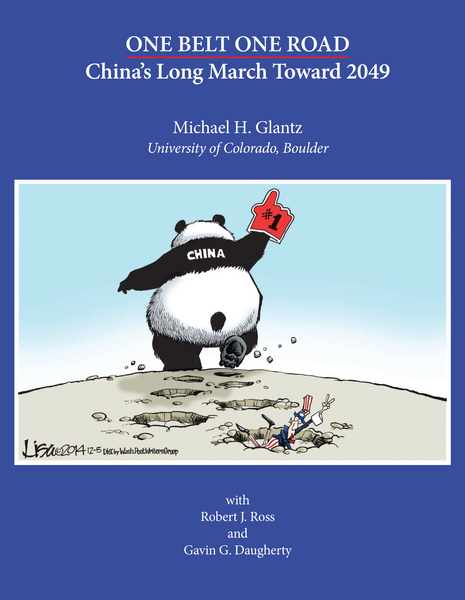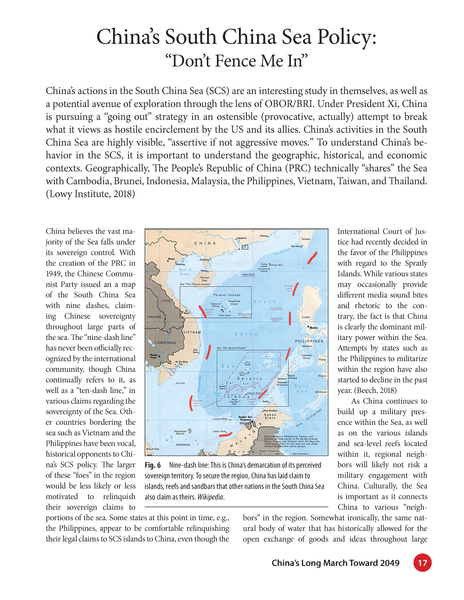China's Long March Toward 2049
One Belt One Road: CHINA'S LONG MARCH TOWARD 2049
Michael H. Glantz, with Robert J. Ross and Gavin G. Daugherty
Consortium for Capacity Building, University of Colorado - Boulder
ISBN 978-1-896559-47-6 (softcover)
A Greenbank Book
122 pages, 8.5 x 11, full color throughout.
40+ illustrations and maps. 200+ references with QR codes.
China’s $4 trillion-dollar initiative launched in 2013 to finance infrastructure projects in more than 70 countries through its Belt and Road Initiative, first known as One Belt One Road. OBOR/BRI is the “brainchild” of China’s President Xi Jinping. It has been called the boldest international development program for the 21st century. The Initiative began as a modern-day version of the ancient Silk Road from China to Europe. Today, however, Xi’s silk roads encircle the globe from Southeast Asia to the Indian Ocean to Africa, Europe and to Latin America. It has expanded to include Space and the Polar regions.
The authors provide readers with glimpses of China’s globalization policy on steroids. OBOR/ BRI can be viewed in a positive light as putting developing countries on fast tracks to development and to China’s global superpower status by 2049. To some, however, OBOR/BRI has been portrayed as an initiative to consolidate China’s position as a regional hegemon with client states, if not a global superpower.
Readers will gain a greater awareness of and appreciation for 21st century international politics as well as for the politics of economic development loans and humanitarian assistance as exposed and discussed by the popular media around the globe.
Contents
Preface
Acknowledgements
From OBOR to BRI
Introduction
Mapping OBOR/BRI: The devil is in the details
PART I Origins of the One Belt One Road Initiative
China’s South China Sea Policy: “Don’t Fence Me In”
China’s “Going Out” Policy and the Belt and Road Initiative
The Power of “One”: The 2008 Beijing Olympics
China’s New Economic and Maritime Silk Roads and Belts
The Geopolitics of OBOR/BRI
“Made in China 2025” and the US
PART II Concepts of OBOR/BRI
Bilateral Tendencies vs. Multilateralism
OBOR’s Belts and Roads as Spheres of Influence
Geographic and Functional Silk Roads as “Campaigns”
PART III The Great Games
Let the Great Games Begin
India, Pakistan, and China
Iran, China, and OBOR/BRI
A Great Game in Greater Central Asia
A Russia-China eventual Great Game over Central Asia?
An emerging Polar Great Game: China’s Polar Maritime Road
A Great Game in Southeast Asia
A Latin American Great Game?
Great Game(s) in “Greater” Europe
A Great Game in sub-Saharan Africa
A Functional Space Silk Road: The Belt and Road Goes 3-D
A Digital Silk Road
Sea Ports as a Functional Silk Road
China’s Silk Road in the Air
OBOR/BRI is not without its Challenges
What OBOR is Not (According to China)
OBOR (SWOC) Chart
PART IV Concluding Comments
Looking back to look ahead
Glimpsing the Future: Thucydides’s Trap
APPENDICES
Image Sources
About the Authors
About the authors
Michael H. Glantz was a Senior Scientist at the National Center for Atmospheric Research (NCAR), where he researched from 1974 to 2009. Since then, he has been the director of the University of Colorado’s Consortium for Capacity Building (CCB). His research publications relate to understanding how extreme climate, water and weather affect societies and how societies affect climate. Since 1976, Glantz has conducted joint research in the former Soviet Union and in the Central Asian Republics on desertification and on the disappearing of the Aral Sea. In 2013 he was recognized by China as a pioneer in desertification studies. Glantz is a member of the Advisory Committee of the international Integrated Risk Governance Program, headquartered at Beijing Normal University. He has lectured on the Climate Affairs concept in several Chinese cities at universities and meteorological centers. He has numerous publications on climate, water and weather issues. Glantz and Professor Qian (BNU and executive director of the IRG) co-authored Usable Thoughts: Climate, Water and Weather in the 21st Century. His current multiyear research is “El Niño Ready Nations,” supported by USAID/OFDA. Many Belt and Road countries are affected by El Niño’s impacts.
In 1990 he received the Global 500 Award of the UN Environment Program (UNEP) that recognizes people working in diverse ways to protect and enhance the planet’s natural resources. Glantz received the 2009 Clinton Global Initiative and Rockefeller Foundation Commitment.
Robert Jay Ross is Project Manager and Research Assistant for CCB. He has been researching societal and environmental issues that result from climate variability, change and extremes. He was invited to attend Beijing Normal University’s summer program for Disaster Risk Reduction (DRR) in 2015, which was focused on social responsibility in Early Warning Systems. He is currently researching an approach to earlier warnings of societal risks of El Niño’s global impacts.
Gavin Goldstein Daugherty earned an MSc degree in Global Politics, Conflict Studies, at the London School of Economics and Political Science (LSE). His research focused on macroeconomic and political analyses of the China-South China Sea and the Russia-Crimea disputes. Prior to attending LSE, Daugherty earned a BA in Political Science from the University of Colorado – Boulder, where he also worked as a Research Assistant at the Consortium for Capacity Building. Daugherty’s research interests include international relations and their economic impacts in the Eurasian region.
IN THE NEWS








